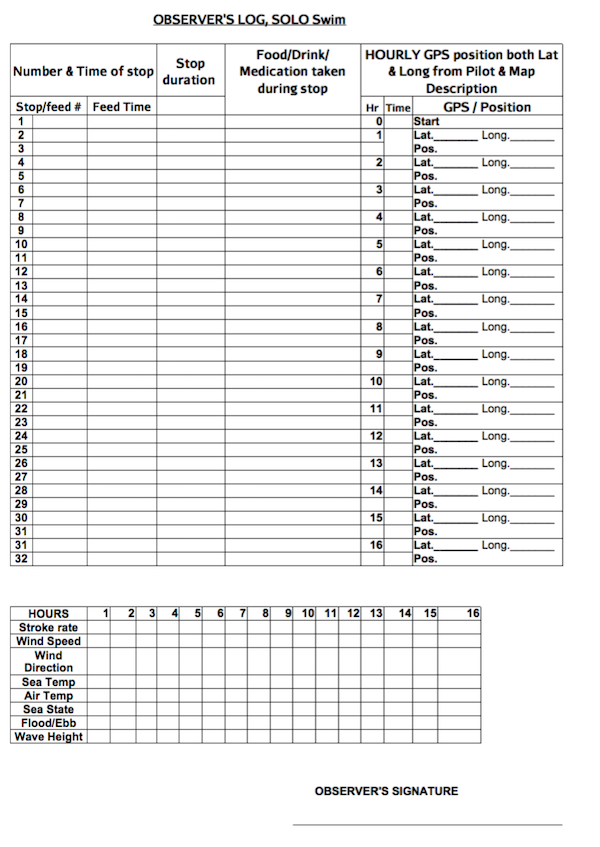Varieties of Observer Logs
A marathon swim observer documents a swim and verifies it was conducted according to the pre-stated rules and standards of conduct. Observers serve a vital role in a sport performed with few first-hand witnesses, often many miles out to sea.
One of the observer’s primary responsibilities is producing documentation. And the primary “document” of this documentation is the Observer Log.
An Observer Log contains timestamped observations, recorded at regular intervals throughout the swim, of several objective and subjective data, including but not limited to:
- geographic position (latitude and longitude)
- water temperature
- air temperature
- wind speed (or force) and direction
- wave height and quality (smooth swells or confused chop)
- swimmer stroke rate (strokes per minute)
- swimmer feeds (product, quantity, etc.)
- other notable events: verbal communications from swimmer, paddler or support swimmer changes, wildlife encounters, etc.
Observer Log formats vary by organization, but often include a crosshatched, graph-paper-like region to facilitate the collection of regular timestamped data. As an example, here’s a page from the MSF Standard Observer Report of Chloe McCardel’s world-record 124.4km Bahamas swim, expertly observed by David Barra and Brianne Yeates:
A tabular, “graph-paper” style log such as MSF’s is convenient and encourages consistent data collection. Other observer logs in this style include:
- Santa Barbara Channel Swimming Association’s swim log
- ILDSA’s North Channel log
- Catalina Channel Swimming Federation’s swim log (not available to view, at the request of the CCSF board of directors)
- Loneswimmer’s Generic Observer Report (modeled on an earlier version of the CS&PF observer log) – Page 1, Page 2

Loneswimmer’s Generic Observer Log
Another format, non-tabular but nonetheless encouraging regular data collection, is seen in the NYC Swim Observer Documented Qualifying Swim log, and the WOWSA observer report.
A more free-flowing, prose-style observer log is also perfectly valid, as long as it still provides regular timestamped observations of the relevant data. Prose-style observer logs can be more engaging to read, and can convey a deeper subjective sense of how a swim unfolded.
Examples of prose-style logs:
- Cathy Delneo’s report on my Round-Trip Angel Island swim.
- My report on Dave Van Mouwerik’s pioneering crossing of Estero Bay, California.
Finally, the CSA and CS&PF take a hybrid approach for English Channel swims, combining a tabular log with a narrative report. Here is an example CS&PF English Channel report.
In my research I found some other, more primitive log styles. Two examples include the “swim verification form” for Hawaii Channel swims, and the BLDSA “swim recognition application.” I don’t consider these sufficient for properly documenting a marathon swim.
In documenting an event that — it bears repeating — few witness in person, my general recommendation is: the more data, the better. In designing the MSF Standard Observer Report, I tried to maximize the efficiency of recording timestamped data (temperatures, wind speeds, stroke rates, etc.), while moving non-time-relevant details (swimmer biographical info, names of support crew, etc.) to a separate page.
A tabular log may produce more consistent results, especially when the experience and personalities of observers vary. I suppose it will surprise no one that I think MSF’s log is best-in-class for the tabular style.
Though it may surprise some that I personally do not use a tabular log when I observe. I prefer to record various data and rough short-hand notes in a simple waterproof notebook. After I’m back on land, I transcribe, expand, and format these rough notes into the finished product, examples of which can be viewed here, here, and here.
I also believe strongly that other forms of documentation enhance the tabular data and provide valuable depth to a swim account. These other forms include:
- Narrative reports (by the observer, swimmer, or members of the crew).
- Photos and video
- GPS tracking data
- Weather and tide data
Among the MSF Documented Swims are numerous examples of deeply, diversely-documented swims, and I encourage anyone planning an independent marathon swim to mine these for inspiration.
Among the major local swim governing bodies, I think the CS&PF are the most sophisticated about documenting swims. Their hybrid tabular+narrative logs, combined with GPS tracking and Sandettie buoy data, provide a wealth of information about the dozens of swims they sanction each year. When we added GPS tracking and NOAA data to the SBCSA website, it was a direct emulation of the CS&PF.
Links
